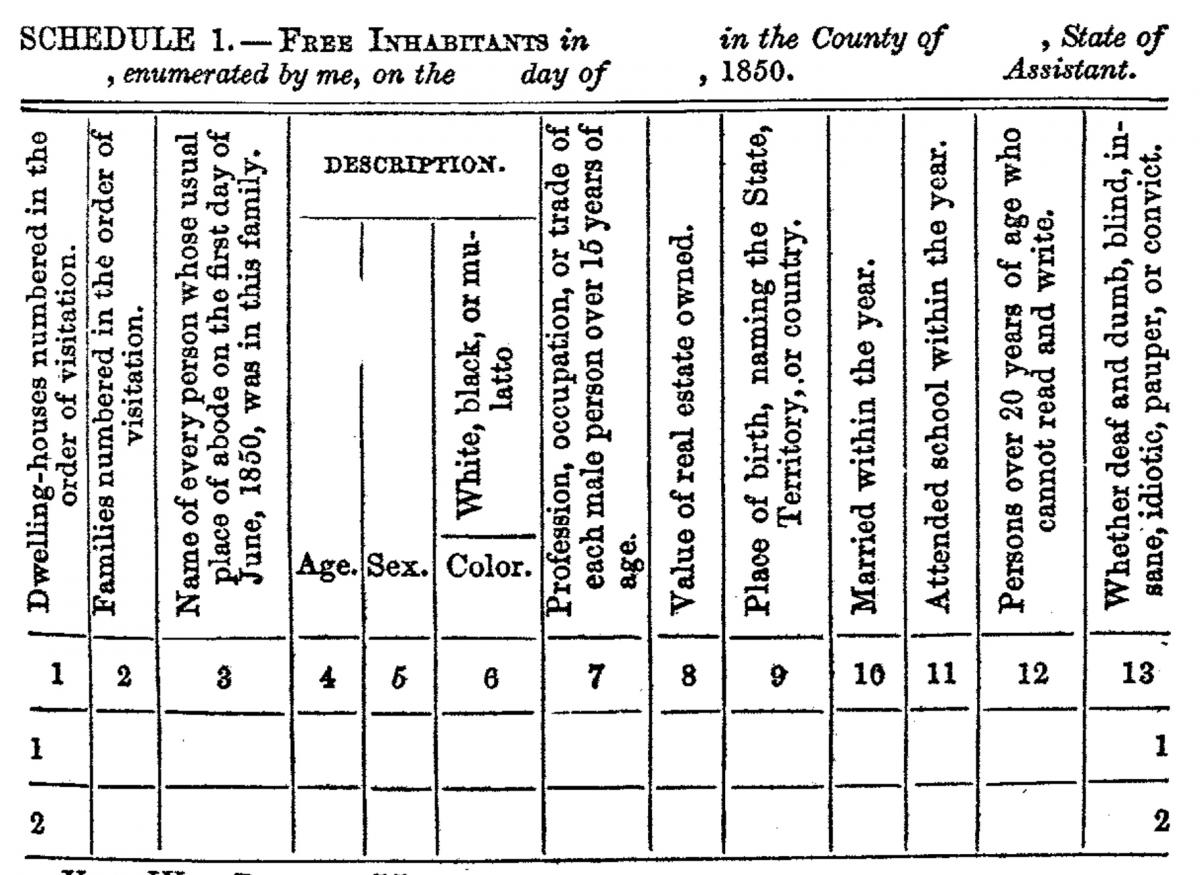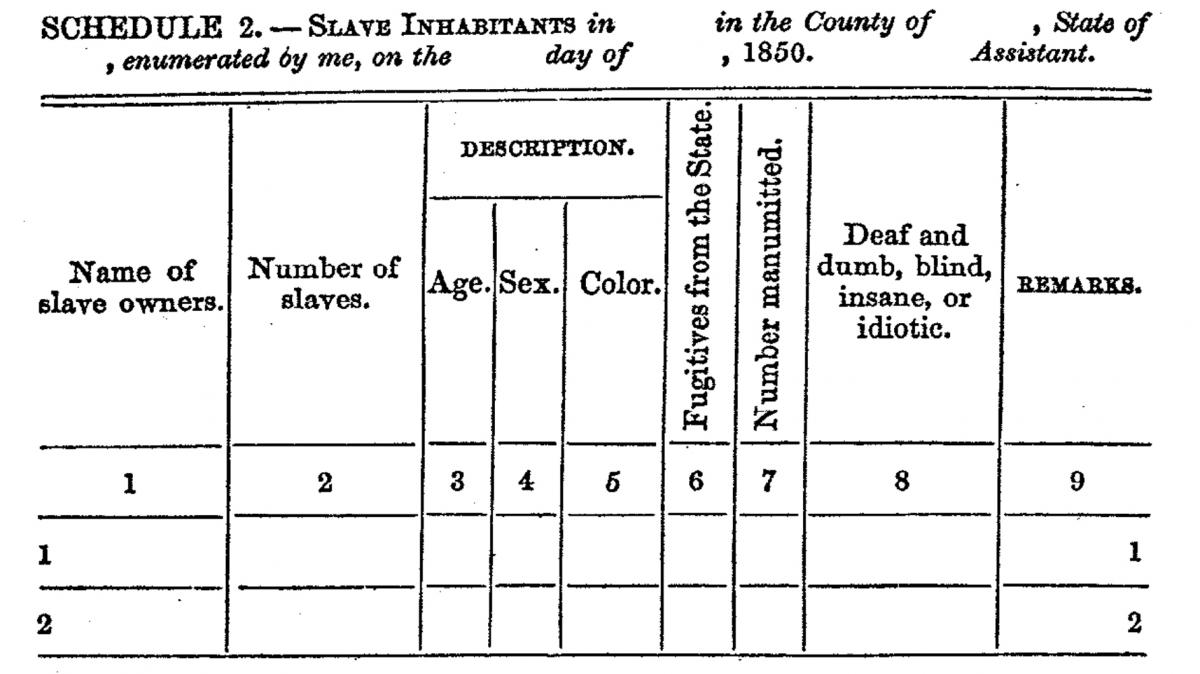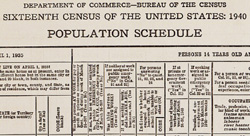
1850 Census Records
The 1850 population census was the Seventh Decennial Census of the United States. Taken every 10 years since 1790, census records provide a snapshot of the nation's population.
Frequently Asked Questions About the 1850 Census
Why was the 1850 Census taken?
Article I, Section 2, of the U.S. Constitution established that representation in the U.S. House of Representatives was based on population determined by a census taken at 10 year intervals: "The actual Enumeration shall be made within three Years after the first Meeting of the Congress of the United States, and within every subsequent Term of ten Years, in such Manner as they [Congress] shall by Law Direct."
What was the official census day?
Saturday, June 1, 1850.
When was it taken?
The census began on Saturday, June 1, 1850, and was finished within 5 months, under the rules and directions established in an Act of Congress approved May 23, 1850 ( “An Act providing for the taking of the seventh and subsequent Censuses of the United States....,” 9 Statutes at Large 428). However, an Act of Congress of August 30, 1850, authorized the Secretary of the Interior to "extend the time for completing the census in California, Oregon, Utah, and New Mexico, to such time as, in his discretion, may be deemed advisable." (9 Statutes at Large 445).
Who was counted?
The law required "all the inhabitants" of each Federal judicial district or territory be enumerated. The Instructions to Marshals and Assistants explained that the the term "usual place of abode" used in column 3 of Schedule 1, Free Inhabitants, meant the "the house or usual lodging place of a person" and that a person "temporarily absent on a journey, or for other purposes, without taking up his place of residence elsewhere, and with the intention of returning again, is to be considered a member of the family...."
Who was involved?
- Secretaries of the Interior Thomas Ewing (1849-50), Thomas M. T. McKennan (1850), Alexander H. H. Stuart (1850-53), and Robert McClelland (1853-57) had general supervision of census operations, tabulation, and reporting the results to the President and Congress.
- Superintendent of the Census J. J. B. DeBow submitted the final statistical report on "The Seventh Census of the United States, 1850" to Secretary McClelland in 1853.
- The U.S. Marshal for each Federal judicial district was responsible for taking the census in his district with the help of assistant marshals whom he appointed. Each took an oath or affirmation that "I will to the best of my ability enumerate, or cause to be enumerated, all the inhabitants of said district ... and will faithfully perform all the duties enjoined on me...." Each assistant marshal took an oath or affirmation that "I will make a true and exact enumeration of all the inhabitants within the district assigned to me, ... and will make due and correct returns thereof..." The act also specified "That each assistant ... shall perform the service required of him, by a personal visit to each dwelling-house, and to each family...." After the information was entered on the forms, "such memoranda shall be immediately read to the person or persons furnishing the facts, to correct errors and supply omissions, if any shall exist."
- Every person over age 20 was required to cooperate: "That each and every free person more than twenty years of age, belonging to any family ..., and in case of the absence of the heads and other members of any such family, then any agent of such family shall be and each of them hereby is, required, if thereto requested by the marshal or his assistant, to render a true account, to the best of his or her knowledge, of every person belonging to such family ... on pain of forfeiting thirty dollars...."
What questions did the census ask?
- Schedule 1 - Free Inhabitants
- Dwelling-house numbered in the order of visitation
- Families numbered in the order of visitation
- Name of every person whose usual place of abode on the first day of June, 1850, was in this family.
- Age
- Sex
- Color (white, black, or mulatto)
- Profession, occupation, or trade of each male person over 15 years of age
- Value of real estate owned
- Place of birth, naming the State, Territory, or country
- Married within the year [hash mark if yes]
- Attended school within the year [has mark if yes]
- Persons over 20 years of age who cannot read and write [hash mark if yes]
- Whether deaf and dumb, blind, insane, idiotic, pauper, or convict [hash mark if yes]
- Schedule 2 - Slave Inhabitants
- Name of slave owner
- Number of slaves
- Age
- Sex
- Color
- Fugitive from the state
- Number manumitted
- Deaf and dumb, blind, insane, or idiotic
- Remarks
What did the census form look like?
The Federal Government provided blank printed forms to the U.S. Marshals. There may be annotations such as certificates of oaths taken, population totals, and handwritten and mechanically-stamped page numbers. For the first time, on March 3, 1849, Congress delegated decisions about the questions to be asked on the census to the "Census Board" whose members were the Secretary of State, Attorney General, and Postmaster General. ("An Act to make Arrangements for taking the seventh Census," 9 Statutes at Large 402). Their recommendations were later incorporated in the forms shown below included by Congress in the act that authorized the taking of the census.
What states and territories are included in the census?
Surviving population census records for free persons include census schedules for Alabama, Arkansas, California, Connecticut, Delaware, District of Columbia, Florida, Georgia, Illinois, Indiana, Iowa, Kentucky, Louisiana, Maine, Maryland, Massachusetts, Michigan, Minnesota, Mississippi, Missouri, New Hampshire, New Jersey, New Mexico, New York, North Carolina, Ohio, Oregon, Pennsylvania, Rhode Island, South Carolina, Tennessee, Texas, Utah, Vermont, Virginia, and Wisconsin. Special notes:
- Slave schedules exist for Alabama, Arkansas, District of Columbia, Florida, Georgia, Kentucky, Louisiana, Maryland, Mississippi, Missouri, New Jersey, North Carolina, South Carolina, Tennessee, Texas, Utah, and Virginia. Following the last page of free population schedules for Utah County, Utah, is a page titled "Slave Inhabitants in Utah County: Deseret" that lists 26 slaves (24 are named) who were enroute to San Bernardino, California.
- Utah became a territory in September 1850. Its official census day was set as April 1, 1851, and was completed in July 1851. The original schedules were then copied (rewritten by hand) and the copy was sent to the U.S. Census Superintendent in Washington, DC, on October 31, 1851. This "federal copy" is now in the National Archives and reproduced on National Archives Microfilm Publication M432, Seventh Census of the United States, 1850, roll 919. The federal copy was written so that known black slaves are listed in the free population schedules along with white persons, in order to give the false impression that there was no one held in slavery in the territory (other than the 26 enroute to California). The original enumeration, which indicated all enslaved individuals, is in the Church History Library of Church of Jesus Christ of Latter-day Saints, Salt Lake City, Utah, as MS 2672, Utah Territorial Census, 1851, with digital images online. For more information, read "The Seventh Census of the United States: Utah and Slavery," Utah Historical Quarterly (Spring 2017).
- West Virginia was part of Virginia.
Are some 1850 census records missing?
Yes. No census schedules exist for:
- California - Counties of Contra Costa, San Francisco, or Santa Clara.
- Tennessee - Bedford County Civil Districts 10 and 12-17.
- It is possible that individual census pages for other locations were lost before they were bound in volumes in the early 1900s.
Where can I see the original 1850 census schedules?
Digital images are online:
- National Archives Microfilm Publication M432, Seventh Census of the United States, 1850 (1,009 rolls), is on popular genealogy websites, including Ancestry.com, FamilySearch.org, and others. (This includes the "federal copy" of the Utah Territorial Census, 1851.
- MS 2672, Utah Territorial Census, 1851 (original enumeration ["territorial copy"]), is online in the Church of Jesus Christ of Latter-day Saints Church History Library online catalog.



